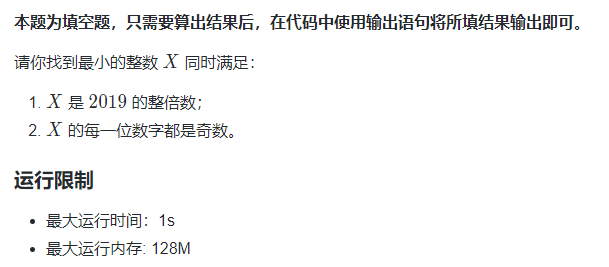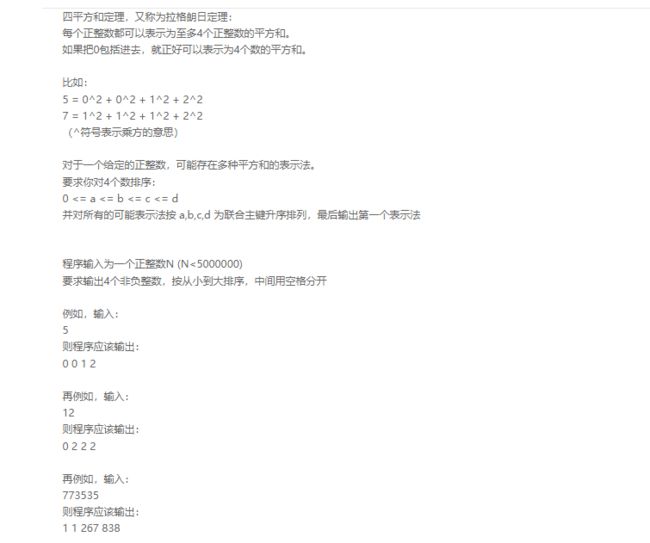【蓝桥杯冲刺 day4】备战蓝桥杯 - 每日刷题解析
题目链接:
奇数倍数
第几个幸运数字
四平方和
迷宫
奇怪的奇数
题目难度:⭐️
解题思路
对于这类题目,从小到大枚举所有2019的整数倍数,判断枚举数的每一位是否为奇数,返回第一个满足条件的数。过程不过多赘述,直接上代码:
#include
#include
int main(int argc, char *argv[])
{
int i=2019;
int x=0;
int n=0;
int num;
for(;i<1000000;i+=2019){
num=i;
// 判断是否为奇数
for(;num>0;num=num/10){
n=num%10;
if(n%2==0){
break;
}
}
if(num!=0){
continue;
}else{
printf("%d\n",i);
break;
}
}
return 0;
}
第几个幸运数字
题目难度:⭐️⭐️⭐️
解题思路
方法有很多,能够使用最小堆解题,时间复杂度是 O ( n l g n ) O(n lgn) O(nlgn),其中n代表所求数字时第 n n n个幸运数字。不过这里我推荐使用三指针+动态规划的做法,具体方法如下:
定义数组数组 d p dp dp从小到大存储所有的幸运数字,我们知道幸运数字一定是只有 3 、 5 、 7 3、5、7 3、5、7为因子的数字,因此任意一个幸运数字一定能够将其乘以 3 、 5 、 7 3、5、7 3、5、7,得到新的幸运数字,也就是说幸运数字一定能够由比它小的幸运数字乘以 3 或 5 或 7 3或5或7 3或5或7推算出来。
那么既然这样对于第 i i i位的幸运数字究竟由哪一位推算出来呢?此时可以定义 i d x 3 i d x 5 i d x 7 idx3 ~idx5 ~idx7 idx3 idx5 idx7 分别存储供应位,表示该位的值提供新的幸运数字,提供的幸运数字分别是 d p [ i d x 3 ] ∗ 3 , d p [ i d x 5 ] ∗ 5 , d p [ i d x 7 ] ∗ 7 dp[idx3]*3 ,dp[idx5]*5,dp[idx7]*7 dp[idx3]∗3,dp[idx5]∗5,dp[idx7]∗7。开始时值都为0, d p [ 0 ] = 1 dp[0]=1 dp[0]=1,此时提供幸运数字分别是:
1 ∗ 3 = 3 , 1 ∗ 5 = 5 , 1 ∗ 7 = 7 1*3 = 3 ,1* 5= 5,1*7=7 1∗3=3,1∗5=5,1∗7=7
获取这三位供应幸运数字的最小值,就是当前位上的幸运数字,如果当前位上的幸运数字大于等于某一个供应位提供的幸运数字,那么表示该位供应的幸运数字已经出现在数组中,该供应位向后移动一位。
循环直到出现最小值也就是当前位幸运数字与所求相等时,返回当前位数 i i i。时间复杂度: O ( N ) O(N) O(N)
如果还是没有思路可以移步这道题的题解丑数 ,观摩大佬们的理解。
#include
#include
#include
using namespace std;
#define ll long long
#define M 10000
#define Target 59084709587505
int main()
{
int arr[3]{ 3,5,7 };
int idx3, idx5, idx7;
idx3 = idx5 = idx7 = 0;
ll dp[M];
memset(dp, 0, sizeof(dp));
dp[0] = 1;
for (ll i = 1; i < M; ++i) {
ll val1 = dp[idx3] * 3;
ll val2 = dp[idx5] * 5;
ll val3 = dp[idx7] * 7;
ll m = min(val1, min(val2, val3));
if (val1<=m) {
dp[i] = m;
++idx3;
}
if (val2<=m) {
dp[i] = m;
++idx5;
}
if (val3<=m) {
++idx7;
dp[i] = m;
}
if (m == Target) {
cout << i << endl;
break;
}
}
return 0;
}
四平方和
题目难度:⭐️⭐️
解题思路
核心思路按照从小到大枚举所有可能出现的情况,要注意:所选的值平方之和不能超过n,且满足a<=b<=c<=d
import java.util.Scanner;
// 1:无需package
// 2: 类名必须Main, 不可修改
public class Main {
public static void main(String[] args) {
Scanner cin=new Scanner(System.in);
int n = cin.nextInt();
for (int a1 = 0; a1 * a1 <= n; ++a1) {
for (int a2 = a1; a2 * a2 + a1 * a1 <= n; ++a2) {
for (int a3 = a2; a3 * a3 + a2 * a2 + a1 * a1 <= n; ++a3) {
int red = n - a1 * a1 - a2 * a2 - a3 * a3;
int sq = (int) Math.sqrt(red);
if (sq * sq == red) {
System.out.println(a1 + " " + a2 + " " + a3 + " " + sq);
return;
}
}
}
}
}
}
迷宫
![]()
☔️解题思路
剖析题目关键字:步数最少 返回结果的字典序最小
- 对于迷宫问题常规解法是 bfs或 dfs算法,为了尽快得到最少的步数,这里使用 bfs 算法
- 为了返回的字典序最小,bfs遍历时依次按照:
D、L、R、U的顺序遍历,返回的结果一定是字典序最小的。
为了不重复到达一个点影响程序性能,可以使用used数组将遍历过的点进行标记,同样也可以将遍历过的点由0该为1防止重复遍历。
⭐️注意:
我的代码中使用了Java流读取同路径下的file.txt文件,如果没有创建该文件写入数据请先创建文件!!!
import java.io.BufferedReader;
import java.io.FileReader;
import java.io.IOException;
import java.util.LinkedList;
import java.util.Queue;
// 1:无需package
// 2: 类名必须Main, 不可修改
public class Main {
public static class Node{
StringBuilder paths;
int x;
int y;
Node(int x, int y,StringBuilder str) {
this.x = x;
this.y = y;
paths = str;
}
}
static char[][] arr = new char[100][100];
static int[][] directs = new int[][]{{1, 0}, {0, -1}, {0, 1}, {-1, 0}};
static char[] directChar = new char[]{'D', 'L', 'R', 'U'};
static int n, m;
public static void main(String[] args) throws IOException {
BufferedReader stream = new BufferedReader(new FileReader("file.txt"));
String str;
while ((str = stream.readLine()) != null) {
m = str.length();
arr[n++] = str.toCharArray();
}
Queue<Node> queue = new LinkedList<>();
queue.add(new Node(0, 0, new StringBuilder()));
while (!queue.isEmpty()) {
Node cur = queue.poll();
int curx = cur.x;
int cury = cur.y;
StringBuilder s = cur.paths;
if (curx == n - 1 && cury == m - 1) {
System.out.println(s);
return;
}
arr[curx][cury] = '1';
for (int i = 0; i < 4; i++) {
int nx = curx + directs[i][0];
int ny = cury + directs[i][1];
if (nx < 0 || ny < 0 || nx >= n || ny >= m || arr[nx][ny] == '1') {
continue;
}
StringBuilder ss = new StringBuilder(s);
ss.append(directChar[i]);
queue.add(new Node(nx, ny, ss));
}
}
}
}


